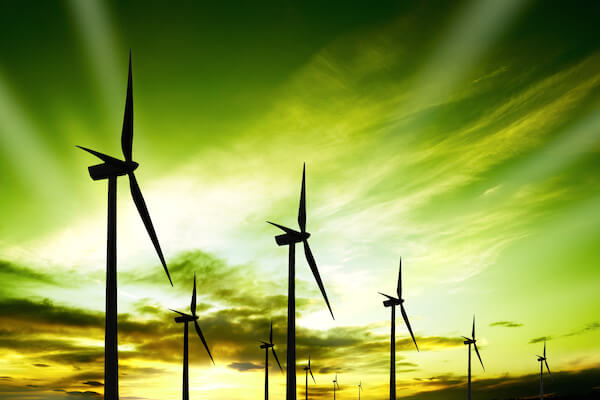Tag Archive for: renewable energy
Jim Dehlsen, a 79-year-old wind-energy pioneer who sold one turbine company to Enron and took another public, has spent his life thinking about the best way to make blades turn in the sky. For his latest effort, he’s flipping a turbine upside down and plunging it dozens of meters into the ocean, in waters that are up to 300 meters deep. There, marine currents rotate the 13.5-meter long blades to pull power from the sea.
Aquantis, Dehlsen’s Santa Barbara, Calif., company, will start deploying turbines in 2018 in waters near Wales and the Isle of Wight. Its most ambitious project is a 200-megawatt field of marine turbines in the strong Gulf Stream off the coast of Florida, due to come online in 2019 or 2020. The world’s oceans remain relatively untapped as an energy source, compared with wind and solar. By 2030, Dehlsen says, marine energy could serve 8 percent or 9 percent of U.S. power needs. “The oceans are the major remaining potential for renewable energy,” he says. “Getting on that now is really urgent.”
It took wind at least 15 years to become a viable, cost-effective resource. In the late 1970s, when scientists first started experimenting with wind turbines, “people laughed at you and said, ‘Wind will never work,’ ” says Robert Thresher, a research fellow at the National Renewable Energy Laboratory in Golden, Colo. In the ’80s and ’90s, the industry settled on the three-blade turbine design considered the standard today. Many aspects of turbine design can be applied to the oceans, adjusted to handle the slower, heftier fluid dynamics of seawater.
Aquantis is developing systems to capture energy from waves, from tidal currents, which switch direction twice a day, and from gyre, or steady, currents. Much of Dehlsen’s obsession these days is with the Gulf Stream. Its constant current can rotate turbines day and night, allowing Aquantis to squeeze more power out of each turbine. That will cut the price per kilowatt-hour. “Because the stream flows all the time, it’s probably the one that can become cost-effective most easily,” Thresher says.
Aquantis, which isn’t the first company to design underwater turbines, wants to lower the cost of marine energy. Dehlsen says deploying an Aquantis device—towing it out to sea, filling it with seawater ballast, then anchoring it—runs about $347,000 per turbine. The rotor’s two blades can withstand huge volumes of water moving as fast as 4 knots. The topmost part floats just above the surface, and the rest of the equipment is held in place with mooring lines to the ocean floor, making it quicker to deploy and cheaper to maintain. Repair crews take an elevator down the shaft. Rival turbine makers dig deep into the ocean floor to anchor the machinery so that it can withstand the strength of the currents; their repairs require raising the structure to the surface. That pushes up the cost significantly, Dehlsen says, to about five to seven times more than Aquantis’s.
Dehlsen plans to install his turbines in a few test sites and sell power to the grid. He sees a second revenue stream in marine turbines housing data centers for the world’s tech giants, using the turbine’s shaft as a storage area for racks of servers. That can save companies money on air conditioning by using cold ocean water to cool the equipment. Aquantis designed and built a pilot test chamber for Microsoft that housed a data center underwater for 105 days off California’s San Luis Obispo pier last year. The test was a success, Microsoft said, with minimal ocean heating and no leaks or hardware failures. Dehlsen is reaching out to Apple, Facebook, and Google about similar efforts.
Dehlsen is courting tech companies and investors while trying to lock down test sites from the north coast of Brazil to Cape Agulhas, on the southern tip of Africa. Little testing has taken place in the U.S. Aquantis has won Department of Energy grants and received some venture capital from Mistubishi Heavy Industries. Dehlsen has self-funded a lot of the work; additional income comes from projects like the data center program. His track record in renewable energy reassures potential partners, says Charles Vinick, Aquantis’s chief executive officer. “Jim is seen as the father of American wind—that opens the door.”
Marine turbines face some challenges, such as concerns over unknown environmental effects. Their blades could strike whales or create noise that confuses sea life. Dehlsen says studies conducted in the U.K. show turbines are safe for fish and marine life. The bigger challenge, he says, is creating marine energy that is cost-competitive. He expects to get to less than 10¢ a kilowatt-hour in three to five years. (Wind energy hovers from 3¢ to 8¢ a kilowatt-hour, solar from 4¢ to 7¢, and conventional gas from 5¢ to 8¢.) “In renewable energy, people get enthusiastic about an idea, and yes, maybe you can make electricity. But if it’s 8¢ a kilowatt-hour, so what?” he says. “Don’t even bother.”
Dehlsen’s best argument may be a slide in his presentation about the urgency of global warming. “The time that’s left in which we can make a change is relatively short,” he says. “Five to 10 years, and you’re beyond being able to stem it.”

New Climate Economy report sets out how Multilateral Development Banks have a crucial role to play in mobilising clean energy investment
The New Climate Economy (NCE) group has this month published a major new report detailing the crucial role development banks need to play in ramping up clean energy investment in developing countries.
The coalition of 20 countries, chaired by former Mexican President Felipe Calderón and Lord Nicholas Stern, has previously said that investments in clean energy are one of the biggest steps that can be taken to close the so-called ’emissions gap’.
By boosting investment to $1tr a year by 2030 yearly greenhouse emissions could be reduced by to 7.5 Gt CO2e, the new report said – an amount bigger than the annual emissions of the United States. Such deep emissions reductions would go a long way towards closing the gap between current projections and the level of emissions cuts needed to stand a reasonable chance of keeping global warming below 2C
However, the new report warns delivering a sharp increase in clean energy investment will require multilateral development banks (MDBs) to play an increasingly active role in supporting the mass deployment of renewable energy in emerging and developing economies.
1.- Development banks are ideal catalysts for clean energy investment
Clean energy had a record year in 2015, attracting $329bn in global investment. However, this is still far short of what is needed both to limit global warming and provide energy access to the 1.1 billion people who still lack it.
MDBs can leverage up to 20 times the amount of money they invest, the report calculates, meaning a big boost in their spending would have a catalytic effect on private sector investment.
2.- MDBs are well positioned to take on risks
While renewables are increasingly competitive in many developing markets with more investment now going into emerging markets than established ones, there are still risks that come with investment in these markets. Exchange rate risks, political risks and construction risk, all of which are higher than in OECD countries, are just some of the ways investors can be deterred from otherwise attractive clean energy projects.
However, since MDBs have a specific remit to promote development in the countries where they work, they are well positioned to take on the risks that other foreign investors may not be willing to shoulder. “They all have a public mandate to enable development globally, and from an energy perspective that is both scaling up energy and making it low carbon at the same time in the next 15 years,” Ilmi Granoff, co-author of the report and senior research associate and the Overseas Development Institute, tells BusinessGreen. “It’s making sure that those risks are addressed for clean energy, and relying on some of the older and new tools to scale up clean energy investments as the core of their energy strategy.”
3.- Co-operation with other players is key
This doesn’t mean that development banks will be taking on all the responsibility alone – a key message from the New Climate Economy is how cooperation between MDBs, governments, and the private sector can allow new projects to be considered that may be too risky for one player to take on alone. Meanwhile, governments will also play an additional important role by scaling up the enabling role they can play in mobilising financing for clean energy, the report notes.
4.-The money is there
A trillion dollars may sound like an awful lot, says Granoff, but there is no global shortage of global capital. Instead, the challenge is to shift incentives to ensure it is unleash in favour of clean energy.
The New Climate Economy group estimates that if low-cost, long-term financing were available for clean energy projects, the cost of clean electricity could be reduced by as much as 20 per cent in developed economies, and 30 per cent in emerging economies.
But in order to unlock this money, the financing system must be re-adjusted to take advantage of the benefits of renewables – their lack of fuel costs, lower operating costs, and flexibility in deployment – while also dealing with the challenges they bring, such as the need for higher grid investment.
“Clean energy is flexible and scalable, it has very low operating costs and often no fuel costs, so it has a bunch of really critical benefits,” says Granoff. “But it also functions differently: the upfront costs are greater, and so the project’s viability is more sensitive to financing costs than fossil fuel power investments. So there’s a bunch of enabling environment issues that have to happen in order to favour that clean energy framework.”
5.- Fossil fuels will have to go
The flip side of the coin, of course, is that while moves are being made to promote and support clean energy, they must also be made to revamp an energy financing structure which until now has heavily benefited fossil fuels.
“It’s not simply about scaling up clean energy investment,” observes Granoff. “If we want the incentives to favour clean energy, we have to incentivising and stop subsidising through public financing high carbon energy systems. We need to be phasing out the financing of carbon energy systems, except in exceptional circumstances where there is an absolutely critical development rational without any viable alternative.

Scroll to top

 Breaking Barriers and Building the Future18 March, 2025
Breaking Barriers and Building the Future18 March, 2025 Fundamental factors to strengthen Pemex12 August, 2019
Fundamental factors to strengthen Pemex12 August, 2019 Offshore Project Development: The Road to First Oil26 July, 2019
Offshore Project Development: The Road to First Oil26 July, 2019
